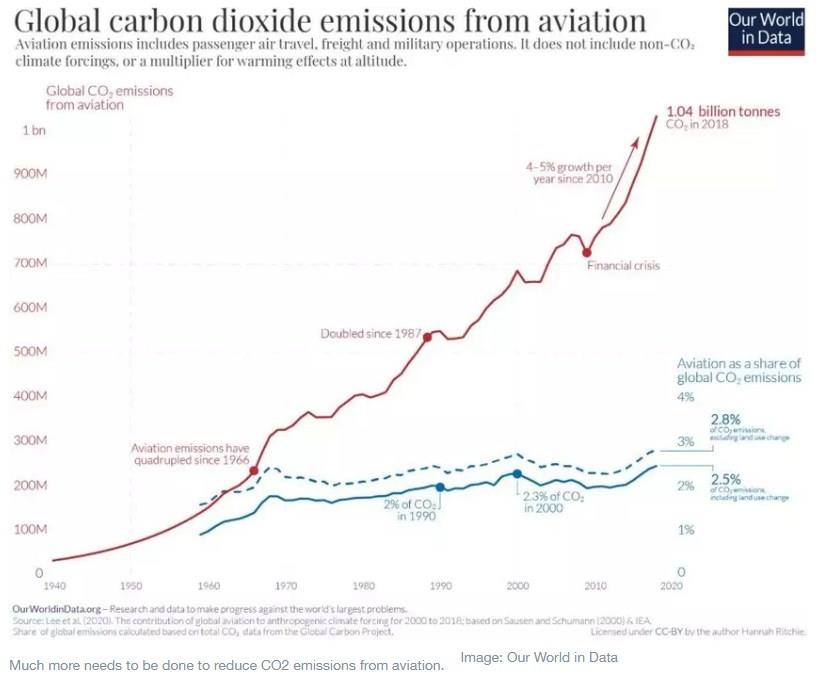by Douglas Broom*
- Global aviation emits more than a billion tonnes of carbon every year.
- But engineering projects under development point the way to zero-carbon flying.
- Here are three concepts with the potential to make air travel environmentally safe.
Aviation is responsible for around 2% of global CO2 emissions. That’s more than one billion tonnes of carbon added to the atmosphere each year. So, the race is on to find alternatives to fossil fuels for planes.

In recent years, new and more efficient engines have helped reduce fuel consumption and harmful emissions. But, despite the impact of the COVID-19 pandemic, global passenger and cargo air traffic is set to grow by 4% a year to 2040.
Aviation industry advocacy body ATAG says fuel efficiency improves by up to 20% with each new generation of aircraft. The problem is the increasing numbers of planes in the air: the world’s commercial airliner fleet is expected to grow from just under 26,000 in 2019 to almost 50,000 by 2040.
So what can be done to make flying more sustainable?
1. Biofuels
If you flew with one of the world’s major airlines in the last decade, your plane may have been partially powered by biofuels. Although they are not in regular use, airlines around the globe have conducted extensive test flights on scheduled services using these fuels.
The sources of sustainable aviation fuels include plant materials like sugar cane and recycled cooking oil. Not only are they renewable, but biofuels emit fewer greenhouse gases even when mixed with conventional jet fuel.
And regulations around the world are changing. From 2022, France will require all flights departing from the country to use at least 1% sustainable aviation fuel. According to European Union (EU) rules all flights departing from European airports will have to use at least 2% sustainable fuels by 2025, rising to 63% by 2050.
The challenge for airlines is biofuels are four times more expensive than conventional jet fuel. Experts say it will become cheaper when more is made. Meanwhile, the EU is banning “tankering” - filling up a plane outside the EU to avoid buying biofuel at a European airport.
2. Hydrogen
Hydrogen fuel cells are already powering buses in many cities around the world. But could this most volatile of gases be the solution to zero-carbon flying? One UK design team believes so and has won a share of a $20 million government fund to develop its design.
The Aerospace Technology Institute’s FlyZero would carry up to 280 passengers - similar seating capacity to the Boeing 787 Dreamliner and the Airbus A330. Using liquid hydrogen stored at minus 250 degrees Celsius in special tanks in the rear fuselage, it could then fly non-stop from London to San Francisco.
And it’s not just hydrogen-powered jets that are in development. Airbus has unveiled its Zero-e concept - a range of zero-carbon hydrogen-powered airliners, which includes an electric-engine propeller airliner that uses hydrogen fuel cells to generate power.
“There’s still the public misconception that hydrogen isn’t safe,” says Airbus Vice President of Zero-Emission Aircraft, Glenn Llewellyn.
“What many people aren’t aware of are the extensive safety precautions that are considered in the design and operation of today’s kerosene-powered aircraft. Due to the rigorous application of these precautions, aviation has an impressive safety record.”
3. Electricity
When a battery-powered plane recently flew across the Cook Strait that separates the North and South Islands of New Zealand it was a big step forward for electric aviation. But the Pipistrel is a two-seater training plane. Will we ever see a battery-powered airliner?
Electric power is vital in the fight to meet future environmental targets, research into greener global transport suggests. While electric aircraft may have been around for decades, experts agree battery technology will have to advance a fair way in terms of both weight and storage to make large, commercial electric planes a reality.
But smaller electric passenger planes are already flying and may be certified for revenue-earning use in the near future, with significant development being seen in larger-plane aviation projects.
An all-electric nine-seater Cessna Grand Caravan 208B, for example, became the biggest battery-powered aircraft ever to take to the skies last year. Magnix, the company whose engines power the electric Cessna, recently won a contract from NASA to develop electric engines for use in an airliner. The five-year project includes flight testing a full-sized plane. Watch this space.
*Senior Writer, Formative Content
**first published in:www.weforum.org




 By: N. Peter Kramer
By: N. Peter Kramer

